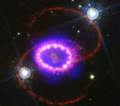Speaker
Francesco Taddia
(Stockholm University, department of Astronomy)
Description
Supernova 1987A revealed that a blue supergiant (BSG) can end its life as a
core-collapse supernova (SN). Such objects show peculiar properties distinguishing
them from ordinary Type IIP SNe, whose progenitors are believed to be red
supergiants. A similarity among 1987A-like events include a long rise to maximum
and peak luminosities which are fainter than Type IIP SNe and mainly powered by
radioactivity.
We investigate two core-collapse SNe that exhibit properties similar to SN 1987A.
Optical and near-infrared light curves and optical spectroscopy of SNe 2006V and
2006au, obtained through the course of the Carnegie Supernova Project, are
presented.These observation are compared to SN 1987A, and are also used to
estimate parameters of their respective progenitor stars. We apply a semi-analytic
model to determine the main physical properties of these objects.
Both SNe and in particular SN 2006V have light curves following the profile exhibited
by SN 1987A, with its characteristic slow rise time. In the first 20 days of the
observation, SN 2006au also present a peculiar slightly decreasing phase (or almost
flat, depending on the filters), which is the signature of the photospheric cooling
phase that ensues shock-wave breakout. Both SNe are brighter than SN 1987A and
the colors indicate these objects to be even strongly bluer, suggesting higher
temperatures. We consistently find higher temperatures by fitting a black body on the
spectral energy distributions. The spectra are consistent with typical Type II
spectra and with the spectra of SN 1987A, but the expansion velocities are higher,
especially for SN 2006au.
These properties suggest a scenario involving BSG progenitors as for SN 1987A, but
larger explosion energies, which we consistently find when we apply the semi-analytic
model. The characteristic compactness that would be required by this kind of
progenitor is confirmed by the radius estimation of SN 2006V and SN 2006au
(respectively 55 and 80 solar radii). We also present an upper limit for the Ni mass
synthesized in both SNe (0.11 solar massesfor SN 2006V and 0.075 solar masses for
SN 2006au).
Author
Francesco Taddia
(Stockholm University, department of Astronomy)

